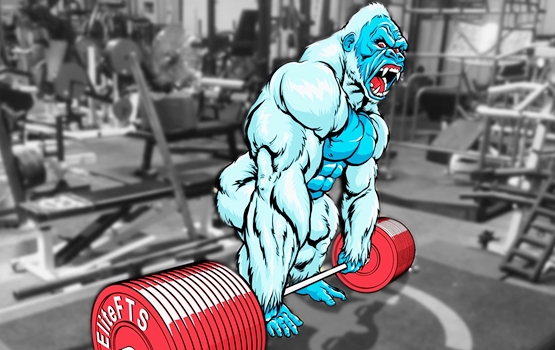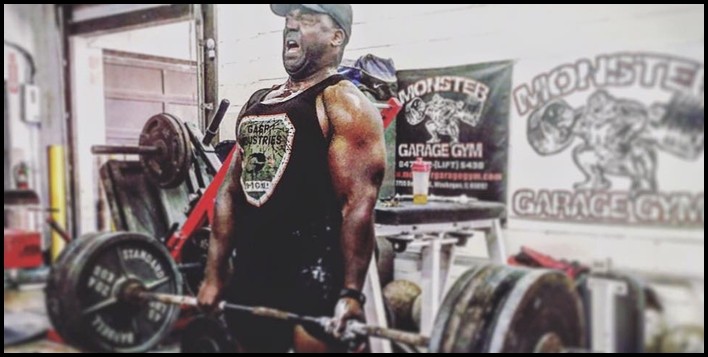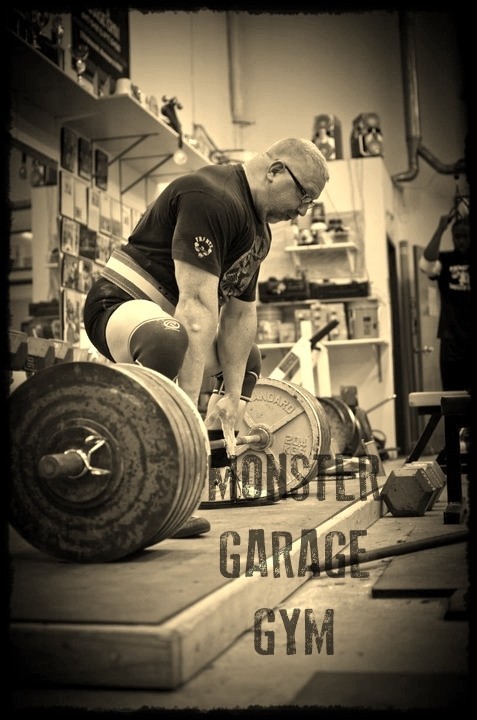
The MONSTER GARAGE GYM/MAROSCHER COACHING LOG is a weekly Coaching Log by MGG owner, 2-Time WPC World Powerlifting Champion, Eric Maroscher, and is one of the Featured Coaching Logs at EliteFTS.
LIVE, LEARN and PASS ON.
MONSTER GARAGE GYM is one of the premier powerlifting gyms in the US.
Monster Garage Gym/Maroscher Coaching Log: (Log number CIV). WHAT DOES THAT MEAN, PULLING THE SLACK OUT OF THE BAR???
*NEW MGG COACHING LOG POSTED HERE EVERY WEEKEND!!!!
________________________________________
When lifting, you can “muscle up the weight,” you can “rip the bar off of the floor,” OR you can use your muscle AND physics and lift a significantly greater amount of weight. In powerlifting, that is the name of the game, lift the most amount of weight. So, the choice is just brute force, or brute force combined with Physics. That choice is up to you.
[youtube=https://www.youtube.com/watch?v=FayAbPA6xlo&feature=youtu.be]
“Pull the slack out of the bar!” This is a phrase often heard in powerlifting gyms when someone is deadlifting. It sounds pretty cool, and the newbie says in response, “Ok,” but do they even know what this means. Do you even know what this means?
Picture this in your mind’s eye if you can. There is a big boat a hundred feet out from the dock and attached to that boat is a very thick rope. The rope is coiled up and is lying on the boat dock and your task is to use that rope and pull the boat to the dock. This will be difficult, as the boat is heavy, but you are strong and that is why you were chosen for the task. So, can you see this in your mind’s eye…the boat off in the distance, sitting motionless on the still waters of the pond? Can you see in your mind’s eye a long thick rope all coiled up on the dock? So here is what you do. You disregard the extra lengths of this thick rope and get the rope to a point where you have both hands on the rope and the rope is made tight so it is basically in a straight line from the boat all the way to the rope. The length of rope is now virtually a straight line running all the way from the boat, across the stretch of water, and straight into your hands. Through common sense, you know that if there is a sagging in the rope and you start pulling and yanking on the rope, you will put all your force into trying to pull the boat but really, all you will do is waste that energy as the boat is not going to get pulled until the rope has no slack to it and is tight as a drum. You know through common sense and experience, if the slack has been pulled out of the rope, and the rope is already slightly pulling into the boat, when you apply your pulling force into the rope that force will travel through the rope that is already snug to the boat and the boat will start to be moved toward you on the dock. In other words, with a sagging rope you have your initial pull, only to be stopped by the weight of the boat, then you have to pull a second time to get the boat to move once the rope is actually tight on the boat.
Super simple, total common sense. It is kind of like pushing a stalled car. You stand against the car, slowly push into the car with more and more energy and through that force into the car, it begins to roll. This works much better than just running and slamming into the car because the sustained force of the body pushing into the car produces the slow movement and inertia required to get the car moving, far more effective than just running and smashing your body into the car.
In both cases, the boat and the car, the weight of the object is greater than the person generating the force so the constant force is advantageous to the blunt force of one big blow to the object.
Moving on, same thing goes with the bar bell and the deadlift, but for whatever reason, that same logic of constant force somehow gets lost in the translation. You can “rip the bar off of the floor” but all the force you put into that pull will be negated once that ¼” to ½” of slack is pulled out of the barbell. Thus, just like the rope for the boat, pulling onto the barbell then in the same motion, lifting the bar off the ground will allow for heavier deadlifts when the weight gets to the point of being your redline max weight.
There is a disconnect sometimes with regard to this concept as the misconception is you can’t be fast if you are also slowly pulling the slack out of the bar. This would be true if this is the lifters first couple of times doing this, as pulling the slack out of the barbell, then moving directly into a fast pull takes practice and coordination.
In this coaching log we have included a video of some examples of pulling the slack out of the bar properly, as well as trying to “rip the bar off of the floor” without taking the time to pull the slack out. You will see in the video some lifters will tug on the bar a couple of times (this is to get a feel for how much bend is in the bar), then you will see they apply pulling tension to the bar….this causes the bar to bend (the bar will only bend so far, meaning a straight bar has slack, but once bent, the slack is now pulled out of the bar) once the bar is bending, the lifter keeps that tension on the bar, then begins forcefully and with speed to pull the barbell and the weight off of the ground. If the bar were straight, and the lifter was to pull with great force and speed into the bar, before the weights come off the ground, the bar would bend, then abruptly the bar would feel the resistance of the weight and that would jar the lifter, it would disrupt the flow of the energy exerted onto the bar and thus the X amount of energy would be reduced as in essence, the lifter would be starting a second pull of the weights.
If you are a physics type of person, think of it this way: you are multiplying the mass (in kg) of the deadlift bar by the force of gravity (9.81,/s^2) (gravity aka the force keeping the bar on the ground) and then you can multiply the distance that barbell is going to be pulled off of the ground, say 3” or so. This formula gives you the amount of work to be able to move the deadlift the desired distance. All that said, if the bar is not already bent, meaning the slack is not pulled out, you have to do this math twice as you basically have to re-apply the initial force, but you have to do so with a reduced amount of your total energy as you only have a finite amount of force to begin with.
So, lots of ways to describe this “pulling the slack out of the bar.” You can think about the boat, the physics problem, or that if the bar is not bending some, then there is still slack in it, or some other way, but they all equal the same ending point. If you are a visual person, I think the video will be the best illustration for you.
When working with folks on the deadlift, this concept is one of the most difficult to get across because driving up a squat or bench press happens only after the barbell has been put in a descending motion and there is already some kinetic energy being built up. Whereas the deadlift is the only lift where the weight is motionless when you start the lift. So yes, the physics for starting the deadlift are important and having that barbell pulled tight and ready to spring into action is key for that last 5-10% you are wanting to get out of your red-line max deadlift.
Wishing you all the best in your training. Ever onward. Eric Maroscher: Monster Garage Gym. Special thanks to Robert, Andrew, Justin and Bill for being a part of this coaching log.
YOU CAN’T KILL A MASTER LIFTER T-SHIRTS NOW AT: The MONSTER GARAGE GYM STORE
Equipment used in this coaching log training video:
• EliteFTS Texas deadlift bar
You can find ALL of the prior EliteFTS/Maroscher Coaching Logs/articles at this link: MAROSCHER ARTICLES/COACHING LOGS
MONSTER GARAGE GYM uses Universal Nutrition/Animal supplements and EliteFTS powerlifting equipment.
________________________________________
You can follow Monster Garage Gym at:
MONSTER GARAGE GYM FACEBOOK
MONSTER GARAGE GYM TWITTER
MONSTER GARAGE GYM INSTAGRAM
MONSTER GARAGE GYM YOUTUBE CHANNEL
MONSTER GARAGE GYM STORE
MONSTER GARAGE GYM WEB PAGE











